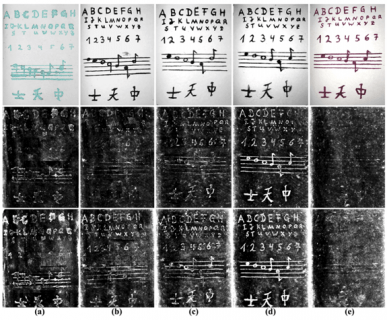Browsing through Sealed Historical Manuscripts by using 3-D Computed Tomography with Low-brilliance X-ray Sources
Daniel Stromer, Vincent Christlein, Christine Martindale, Patrick Zippert, Eric Haltenberger, Tino Hausotte & Andreas Maier
Severely damaged historical documents are extremely fragile. In many cases, their secrets remain concealed beneath their cover. Recently, non-invasive digitization approaches based on 3-D scanning have demonstrated the ability to recover single pages or letters without the need to open the manuscripts. This can even be achieved using conventional micro-CTs without the need for synchrotron hardware. However, not all manuscripts may be suited for such techniques due to their material and X-ray properties. In order to recommend which manuscripts and which inks are best suited for such a process, we investigate six inks that were commonly used in ancient times: malachite, three types of iron gall, Tyrian purple, and buckthorn. Image contrast is explored over the complete pipeline, from the X-ray CT scan and page extraction to the virtual flattening of the page image. We demonstrate, that all inks containing metallic particles are visible in the output, a decrease of the X-ray energy enhances the readability and that the visibility highly depends on the X-ray attenuation of the ink’s metallic ingredients and their concentration. Based on these observations, we give recommendations on how to select the appropriate imaging parameters.
Reference
Stromer, D., Christlein, V., Martindale, C. et al. Browsing through sealed historical manuscripts by using 3-D computed tomography with low-brilliance X-ray sources. Sci Rep 8, 15335 (2018). https://doi.org/10.1038/s41598-018-33685-4
